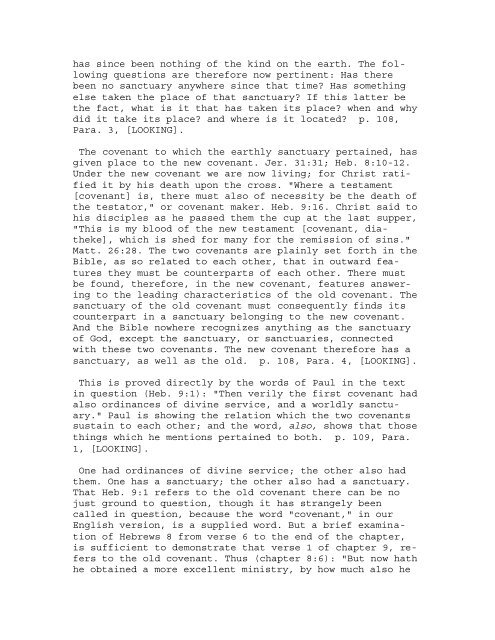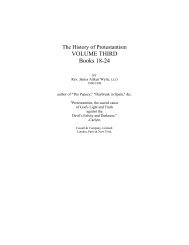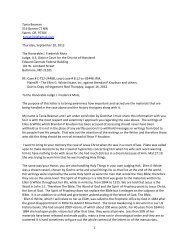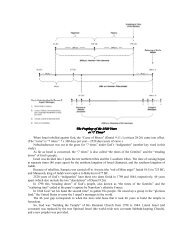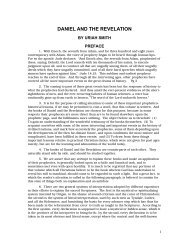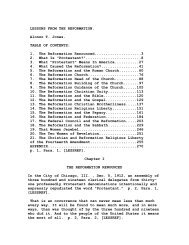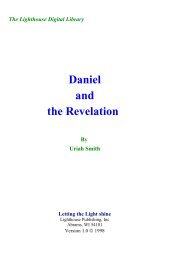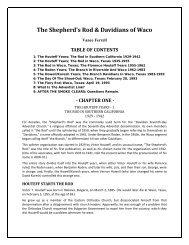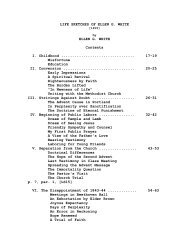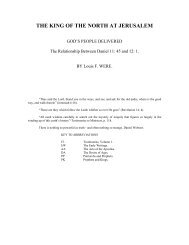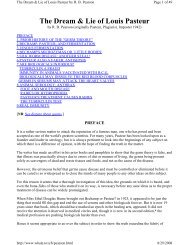LOOKING UNTO JESUS OR CHRIST IN TYPE AND ANTITYPE. BY ...
LOOKING UNTO JESUS OR CHRIST IN TYPE AND ANTITYPE. BY ...
LOOKING UNTO JESUS OR CHRIST IN TYPE AND ANTITYPE. BY ...
You also want an ePaper? Increase the reach of your titles
YUMPU automatically turns print PDFs into web optimized ePapers that Google loves.
has since been nothing of the kind on the earth. The following<br />
questions are therefore now pertinent: Has there<br />
been no sanctuary anywhere since that time? Has something<br />
else taken the place of that sanctuary? If this latter be<br />
the fact, what is it that has taken its place? when and why<br />
did it take its place? and where is it located? p. 108,<br />
Para. 3, [<strong>LOOK<strong>IN</strong>G</strong>].<br />
The covenant to which the earthly sanctuary pertained, has<br />
given place to the new covenant. Jer. 31:31; Heb. 8:10-12.<br />
Under the new covenant we are now living; for Christ ratified<br />
it by his death upon the cross. "Where a testament<br />
[covenant] is, there must also of necessity be the death of<br />
the testator," or covenant maker. Heb. 9:16. Christ said to<br />
his disciples as he passed them the cup at the last supper,<br />
"This is my blood of the new testament [covenant, diatheke],<br />
which is shed for many for the remission of sins."<br />
Matt. 26:28. The two covenants are plainly set forth in the<br />
Bible, as so related to each other, that in outward features<br />
they must be counterparts of each other. There must<br />
be found, therefore, in the new covenant, features answering<br />
to the leading characteristics of the old covenant. The<br />
sanctuary of the old covenant must consequently finds its<br />
counterpart in a sanctuary belonging to the new covenant.<br />
And the Bible nowhere recognizes anything as the sanctuary<br />
of God, except the sanctuary, or sanctuaries, connected<br />
with these two covenants. The new covenant therefore has a<br />
sanctuary, as well as the old. p. 108, Para. 4, [<strong>LOOK<strong>IN</strong>G</strong>].<br />
This is proved directly by the words of Paul in the text<br />
in question (Heb. 9:1): "Then verily the first covenant had<br />
also ordinances of divine service, and a worldly sanctuary."<br />
Paul is showing the relation which the two covenants<br />
sustain to each other; and the word, also, shows that those<br />
things which he mentions pertained to both. p. 109, Para.<br />
1, [<strong>LOOK<strong>IN</strong>G</strong>].<br />
One had ordinances of divine service; the other also had<br />
them. One has a sanctuary; the other also had a sanctuary.<br />
That Heb. 9:1 refers to the old covenant there can be no<br />
just ground to question, though it has strangely been<br />
called in question, because the word "covenant," in our<br />
English version, is a supplied word. But a brief examination<br />
of Hebrews 8 from verse 6 to the end of the chapter,<br />
is sufficient to demonstrate that verse 1 of chapter 9, refers<br />
to the old covenant. Thus (chapter 8:6): "But now hath<br />
he obtained a more excellent ministry, by how much also he


